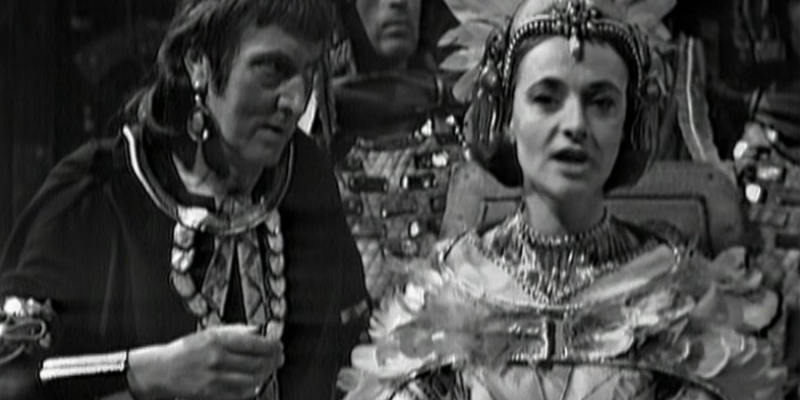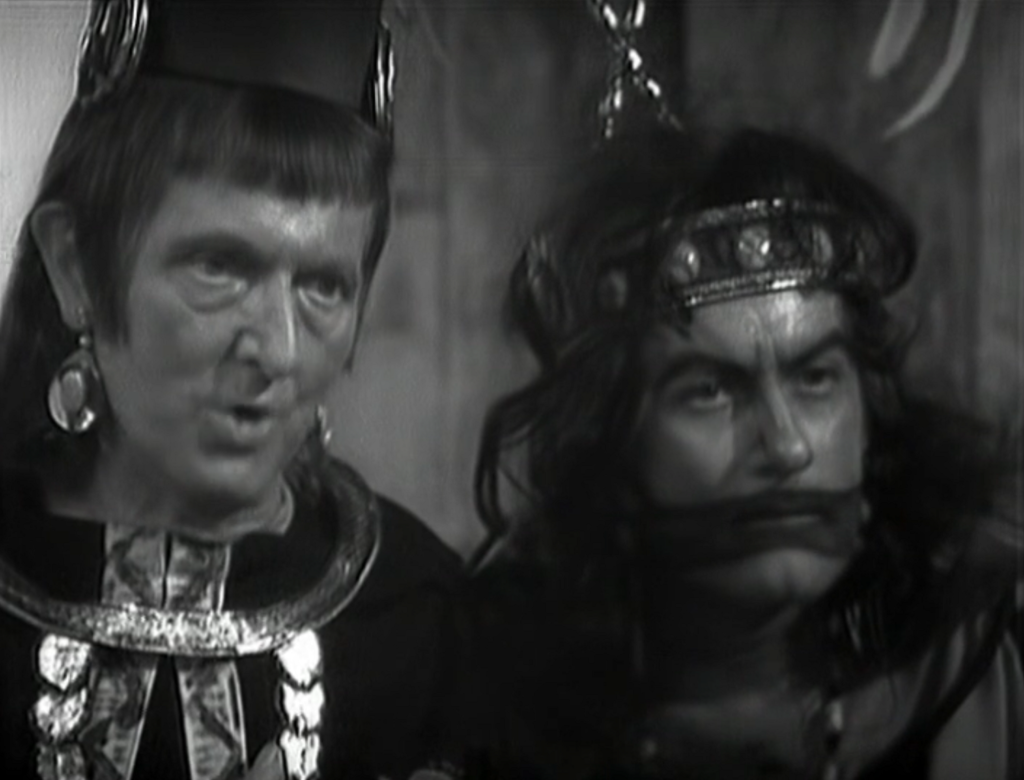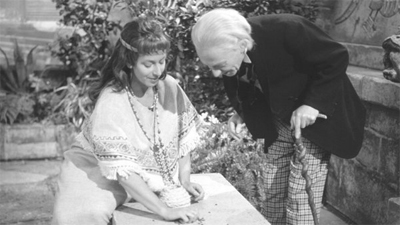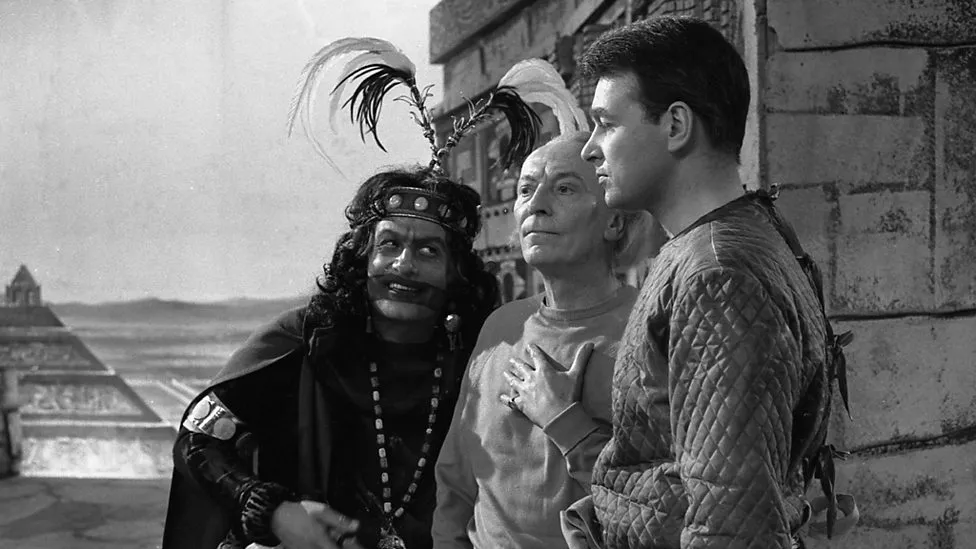The Doctor: First Doctor (William Hartnell)
The Companions: Susan (Carole Ann Ford), Barbara (Jacqueline Hill), Ian (William Russell)
The plot: In Mexico in the 15th century, Barbara is mistaken for an Aztec Goddess and tries to put a stop to human sacrifice
Written by: John Lucarotti
First aired: 23/05/1964-14/06/1964
Continuity: There are fixed points in history that cannot be changed
Season 1, Episode 17-30 review
Barbara: If I could start the destruction of everything that is evil here, then everything that is good would survive when Cortez lands.
The Aztecs
Doctor: But you can’t rewrite history! Not one line!

To this day, The Aztecs remains one of the best episodes of Doctor Who ever made. And I say that well aware that it has no aliens, no ‘timey wimey’, no cheap fantasy tricks of any kind. It’s just a well-written and well-executed story; a thoughtful, and nuanced study of a great civilisation in human history.
What John Lucarotti got wrong in Marco Polo, he got absolutely right in The Aztecs. His central conceit remains the same – our protagonists are separated from the TARDIS and must get back to it to be able to escape – however, that isn’t everyone’s single overriding motivation.
History teacher and Aztec specialist, Barbara, wants desperately to save this thriving and advanced civilisation from the brutal march of colonialism. But while the Doctor’s resistance to this appears to be a pedantic kneejerk one, The Aztecs instead gives us a human answer to the question of whether history can be changed.
Every society has great things and terrible things within it, the sincere and the cynical. With culture and custom comes power and those who have that power do not give it up easily. In the end, Barbara’s attempts to save the Aztecs does not fail because of the weight of history. It fails because it would mean changing who the Aztecs are. And no single human being, even one revered as a God, can do that.
As a civilisation, Lucarotti sensitively portrays the Aztecs in all their contradictions. The love of learning and science and the cruelty of religion. The gentle and comfortable retirement given to all their citizens and the militarism of its youth. The genius of engineering and architecture and the ascendance of illogical superstition. The latter giving rise to its culture of ritual sacrifice.
SUSAN: The little I know about them doesn’t impress me. Cutting out people’s hearts.
The Aztecs
BARBARA: Oh, that was only one side to their nature. The other side was highly civilised.
SUSAN: The Spanish didn’t think so.
BARBARA: They only saw the acts of sacrifice. That was the tragedy of the Aztecs. The whole civilisation was completely destroyed, the good as well as the evil.
It’s obviously debatable as to whether Cortez really cared about human sacrifice or if he saw it as an excuse to sack and pillage an empire rich in precious metals. Nonetheless, it’s clear that Barbara believes it and so, when she’s mistaken for the Aztec God, Yetaxa, she sees her opportunity to save the civilisation from genocide.
The High Priests, we soon learn, know very well that human sacrifice is unnecessary to stop eclipses or to make it rain. But the rituals are the core of their power and, while the more enlightened among them want the practice to end, the bulk of the leadership want the status quo to continue. As they always do.
These two binary tensions within Aztec society are represented by Autloch, the High Priest of Knowledge, and Tlotoxl, the High Priest of Sacrifice. “Beauty and horror developing hand in hand,” as Susan describes them.

While Barbara stays in the temple giving a sterling performance as Yetaxa, Ian is manipulated into taking a military position that puts him in direct opposition to the young and ambitious, Ixta (he’s a British chemistry teacher but we all know he’s somehow also mastered a plethora of martial arts). The Doctor is sent to the Garden of Peace: a place where all citizens aged 52 years and over are allowed to spend their days free from responsibility but venerated for their accumulated wisdom and knowledge.
Despite the Doctor’s attempts to dissuade Barbara, she’s determined to put a stop to the practice of human sacrifice. As the High Priests arrange a ‘miracle’ of rain that is brought about by a sacrifice and the appearance of Yetaxa herself, Susan cries out against the killing and Barbara does her best to stop it. It’s to no avail as the intended victim kills himself rather than face the shame and ignominy of continuing to live.
Human sacrifice is their tradition. Their religion. There’s nothing we can do about it
The Doctor, The Aztecs
Susan has unknowingly violated local law (although I suspect this is not ignorance so much as her usual juvenile idiocy) and is sent off to the local seminary to learn their customs and beliefs (as a militaristic culture, this knowledge is of the housekeeping kind). Seeing his power threatened, Tlotoxl comes to the only conclusion he can: Yetaxa is a false God who must be destroyed. The irony being of course that he happens to be right.

The Doctor and Barbara have a fierce argument about their situation. Cut off from the TARDIS and with no way (yet) to leave, their safety is entirely at the whim of local powerbrokers, a safety that Barbara’s meddling has jeopardised. I find it interesting at this point in the season that Barbara is the companion to whom the Doctor addresses as an equal. Susan he treats as a child, Ian a soldier he commands, but Barbara a true equal: one he can remonstrate with but cannot order.
Jacqueline Hill imbues Barbara throughout this serial with intelligence, grace and steel. She matches wits with Tlotoxl, inspires an existential crisis in the genuine Autloch and manages to navigate her way through a society that is increasingly rebelling against her efforts.
While Ian displays a pre-Star Trek knowledge of the Vulcan neck pinch in an ongoing physical battle with Ixta, the Doctor is set on inveigling the knowledge of the room the TARDIS is entombed in from a woman called Cameca in the Garden of Peace. There’s a great deal of impish flirting going on, something that is not unnoticed by other residents of the Garden. While the Doctor seems genuinely impressed with Cameca, he is no doubt also being manipulative. Nonetheless, he finds himself in a bind when he accidentally gets engaged in a scene that is surprisingly funny.

As the beloved of the original architect, the Doctor believes Cameca may have the secret to entering the tomb. That secret, it turns out, might lie with the architect’s son, Ixta, whom Ian has just humiliated by rendering him unconscious without striking a blow. To help Ixta save face and to rid Yetaxa of one of her servants, Tlotoxl has orchestrated a battle to the death between the two men.
The Doctor gives over botanical knowledge to help Ixtra drug his opponent, not realising that opponent is Ian. Ian is felled by the drug and Ixta wins the fight but before he can kill him, Barbara storms in and threatens Tlotoxl’s life to save Ian’s. While it works, it does not add to her reputation as a God and Ixta joins the ranks of those who want to see her downfall.

And here is the main crux of the story. That Tlotoxl is not some evil outlier who is determined to take his society down the wrong path for his own benefit. He is instead the inevitable result of a society that already embraces those beliefs. Tlotoxl is not the odd man out here, Autloch is. And he’s just one man. Barbara may be able to fight Tlotoxl but she cannot fight an entire way of life.
You’re monsters. All of you, monsters!
Susan, The Aztecs
As the Doctor discovers a way into the temple through his (somewhat hilarious) accidental engagement to Cameca, Barbara decides she’s had enough of this deceit and admits outright to Tlotoxl that she is not Yetaxa. She is nonetheless determined, along with a recruited Autloch, to stop the planned sacrifice for an upcoming eclipse. Tlotoxl, having worked out that Barbara’s weakness is in her care for her companions, manipulates Susan into breaking the law again and this time Barbara has no choice but to agree to her punishment.

As night falls, Ian crawls through the tunnel entrance the Doctor has discovered in the garden and manages to escape the wrathful Ixta’s revenge plan to find a way into the tomb.
With their means of escape mapped out – and Barbara having had enough of being King Canute – the TARDIS crew prepares to leave. Any desire Barbara may have had to stay and keep trying to save the Aztecs from themselves is destroyed by Tlotoxl’s scheming. He has Ixta attack Autloch and frame Ian. With his spiritual crisis reaching a crescendo, Autloch, the personification of knowledge, wanders into the wilderness. Rationality is destroyed. Superstition wins. And the Aztecs are doomed.
The Aztecs is a classic tragedy in the truest version of the genre and yet the tragedy for Barbara and her companions is that of the observer of atrocity. With the benefit of hindsight, we can say that this moment was a fixed point in spacetime, one that cannot be changed. But what made The Aztecs such an exceptional story was its grounding of that tragedy in the ordinary and familiar foibles of humanity. You can save someone from an external threat but you cannot save them from themselves.




Yes, The Aztecs is one of the finest Who stories. They, the Aztecs, certainly were a contradiction on the surface. I did study them as an undergraduate many years ago and my dissertation was on the rise of civilisation based on the importance hydrology. One of the great mysteries was how the Aztecs went from a little known tribe to a civilisation of 5M people, almost (well in archaeological terms) overnight. They understood early on the power of terror. With 500 vassal states, like the Roman’s they knew they could leave those sympathetic to their way of life in charge and pay tributes accordingly. One such practice that really struck such terror was the skinning of those defeated and not necessarily human sacrifice. This created such hatred that when Cortez turned up, many of the vassals openly rebelled and the rest is history. Apart from all this, the Aztec calendar operated over a 52 year cycle, hence the importance of 52 amongst those who lived beyond such an age.